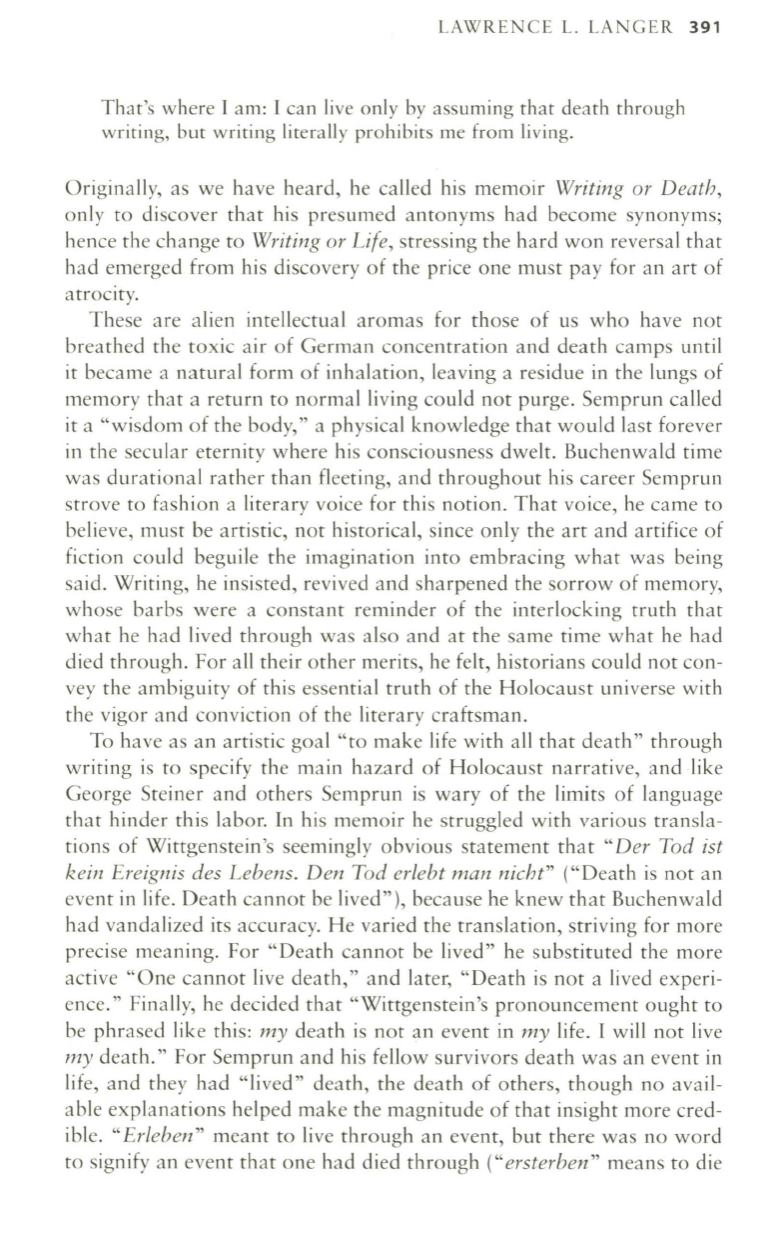
LAWRENCE L. LANGER
391
That's where I am: I can live only by assuming that death through
writing, but writing literally prohibits me from living.
Originally, as we have heard, he called his memoir
Writing or Death,
only to discover that his presumed antonyms had become synonyms;
hence the change to
Writing or Life,
stressing the hard won reversal that
had emerged from his discovery of the price one must pay for an art of
atrocity.
These are alien intellectual aromas for those of us who have not
breathed the toxic air of German concentration and death camps until
it became a natural form of inhalation, leaving a residue in the lungs of
memory that a return to normal living could not purge. Semprun called
it a "wisdom of the body," a physical knowledge that would last forever
in the secular eternity where his consciousness dwelt. Buchenwald time
was durational rather than fleeting, and throughout his career Semprun
strove to fashion a literary voice for this notion. That voice, he came to
believe, must be artistic, not historical, since only the art and artifice of
fiction could beguile the imagination into embracing what was being
said. Writing, he insisted, revived and sharpened the sorrow of memory,
whose barbs were a constant reminder of the interlocking truth that
what he had lived through was also and at the same time what he had
died through. For all their other merits, he felt, historians could not con–
vey the ambiguity of this essential truth of the Holocaust universe with
the vigor and conviction of the literary craftsman.
To have as an artistic goal "to make life with all that death" through
writing is to specify the main hazard of Holocaust narrative, and like
George Steiner and others Semprun is wary of the limits of language
that hinder this labor. In his memoir he struggled with various transla–
tions of Wittgenstein's seemingly obvious statement that"
Der Tod ist
kein Ereigllis des Lebens. Den Tod erlebt man nicht"
("Death is not an
event in life. Death cannot be lived"), because he knew that Buchenwald
had vandalized its accuracy. He varied the translation, striving for more
precise meaning. For "Death cannot be lived" he substituted the more
active "One cannot live death," and later, "Death is not a lived experi–
ence." Finally, he decided that "Wittgenstein's pronouncement ought to
be phrased like this:
my
death is not an event in
my
life. I will not live
my
death." For Semprun and his fellow survivors death was an event in
life, and they had "lived" death, the death of others, though no avail–
able explanations helped make the magnitude of that insight more cred–
ible.
"Erleben"
meant to live through an event, but there was no word
to signify an event that one had died through
("ersterben"
means to die


